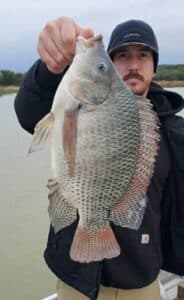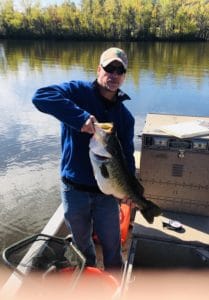Less algae and bigger bass, naturally.
Tilapia are a member of the Cichlid family and are native to tropical regions of the world. Due to the benefits they provide, they have been widely introduced in areas outside of their natural range. Aside from being excellent table fare, they also have an appetite themselves for aquatic weeds and algae. They can be used to help control duckweed, watermeal, and various types of algae in private bodies of water throughout Texas. Tilapia are also commonly stocked as forage to promote optimum growth in largemouth bass. They evolved in warm, tropical waters and most species are unable to survive in water temperatures below 50 degrees F.
Tilapia are an exotic species and therefore regulated by state fish and wildlife agencies. In Texas, four species are legal to transport and stock into private water. These include the blue, Nile, Mozambique, and Wami. Mozambique and Nile species are the most readily available here in north Texas.

Full Grown Tilapia
A permit to stock tilapia into your pond may be needed.
If you reside in north central Texas, a permit will NOT be required. However, the panhandle, far west, and hill country regions of the state will require a permit from the Texas Parks & Wildlife Department prior to stocking.

Tilapia Stocking Zones (TPWD)
Tilapia are highly fecund and once stocked, they will reproduce throughout the summer. They are a “mouthbrooding” species; this means the female holds the eggs in her mouth until they hatch. This increases their likelihood of survival. Once the female expels the fry, they immediately begin to feed on phytoplankton and single cell algae. Newly hatched tilapia will grow rapidly in highly fertile waters. As they continue to grow, they gradually shift their diet to vegetation and filamentous algae. They rarely compete with native fish species for available food.
Largemouth bass prefer to feed on the largest prey available in a pond or lake. Feasting on tilapia results in maximum energy-to-weight conversion. Stocking tilapia also takes pressure off of native forage species. This promotes a natural increase in the numbers of bluegill, redear sunfish, and shad. Therefore, we often recommend tilapia for poorly managed lakes where bass have become overpopulated and reduced the amount of sustainable forage present. This all equates to bigger bass!
What happens to Tilapia when water temperature drops?
As mentioned earlier, tilapia will die once water temperatures drop below 50 degrees F. They become sluggish as the water begins to cool in the fall; making them an easy target for hungry bass trying to fatten up in preparation for winter. Therefore, in ponds with large populations of adult bass, you typically will not notice large scale die offs in the winter. On the other hand, ponds with low numbers of predators will likely have dead tilapia near the shoreline after the first major cold front of the season.

Trophy Bass Raised on Tilapia
Tilapia should be stocked in the spring at a rate of 10-20 pounds per surface acre. They should be supplemented with artificial feed when stocked primarily for enhanced bass growth. However, if used strictly for algae or vegetation control, this will take away from their intended purpose. They should be re-stocked every spring for maximum benefits. For more information on fish stocking, please refer to our blog post Fish Stocking Chart and Recommendations.
